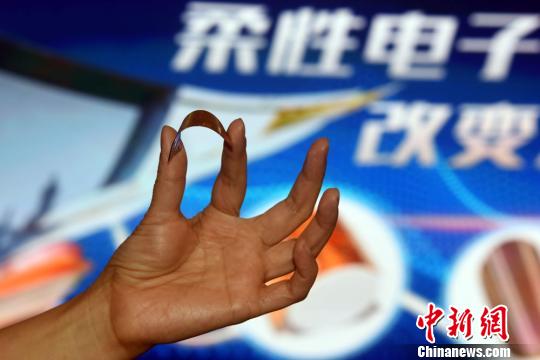Flexible chips foretell remarkable future
- By Wu Jin
 0 Comment(s)
0 Comment(s) Print
Print E-mail China.org.cn, July 17, 2019
E-mail China.org.cn, July 17, 2019

The rollout of two flexible, thin chips at the International Conference on Flexible Electronics held in Hangzhou, Zhejiang province, have demonstrated China's strong foray into the arena of flexible electronic technologies.
Each of the two integrated circuits, designed by the Global Research Center for Flexible Electronics & Intelligent Technology, established only just over a year ago in Hangzhou, features a thickness no more than a quarter of a hair's width.
Apart from the chips, the center has adopted flexible technologies into making ultrasonic communication devices, high-density sensors and soft robots.
Feng Xue, director of the Research Center of Flexible Electronics Technologies, Tsinghua University, said, "From the general view of development, the technology, focusing on the engineering designs of softened hardware, is changing the rigid physical elements in the electronic system."
Despite the market appearance already of foldable smart phones, some experts believe the technology has much room for improvement.
According to Shen Yang, deputy dean of the School of Materials Science and Engineering at Tsinghua University, hundreds of electronic elements in a foldable smart phone remain rigid. Therefore, if they can be softened, the phone can be folded in multiple ways or even rolled.
"Today, most electronic technologies are made from silicon semiconductors. If the material is softened, we can soon attain flexible electronic elements based on the current processing technologies," he said.
Flexible electronic technologies can also be applied to medical treatment. According to Feng, the elements can be made as thin and soft as facial masks. Being put around the trigonum of the nose, they can monitor respiratory frequencies in 24 hours.
The application of the technology can also inspire the immense imagination available in many sectors, such as artificial intelligence and interconnectivity between people and machines.
According to Shen, robots will have tender arms and legs and their sensors will be more sensitive than those of human beings.
In addition, the connection between human and machines can be fostered by transmitting brain signals to computers.
According to Chen Xiaodong, professor from the Nanyang Technological University of Singapore, concepts evolving from the internet of things to the internet of human bodies are emerging internationally. With the help of softened sensors, the physical elements of people's body temperatures, impulses and brain signals can be connected to the Internet.
"The technology can acquire, manage, transmit and present information and empower the flexible use of energies. Biological compatibility will probably enable the Internet to connect every possible element in the world," said Feng.
According to him, the overwhelming transformation caused by the technology is approaching and the world needs to prepare for it.






Go to Forum >>0 Comment(s)